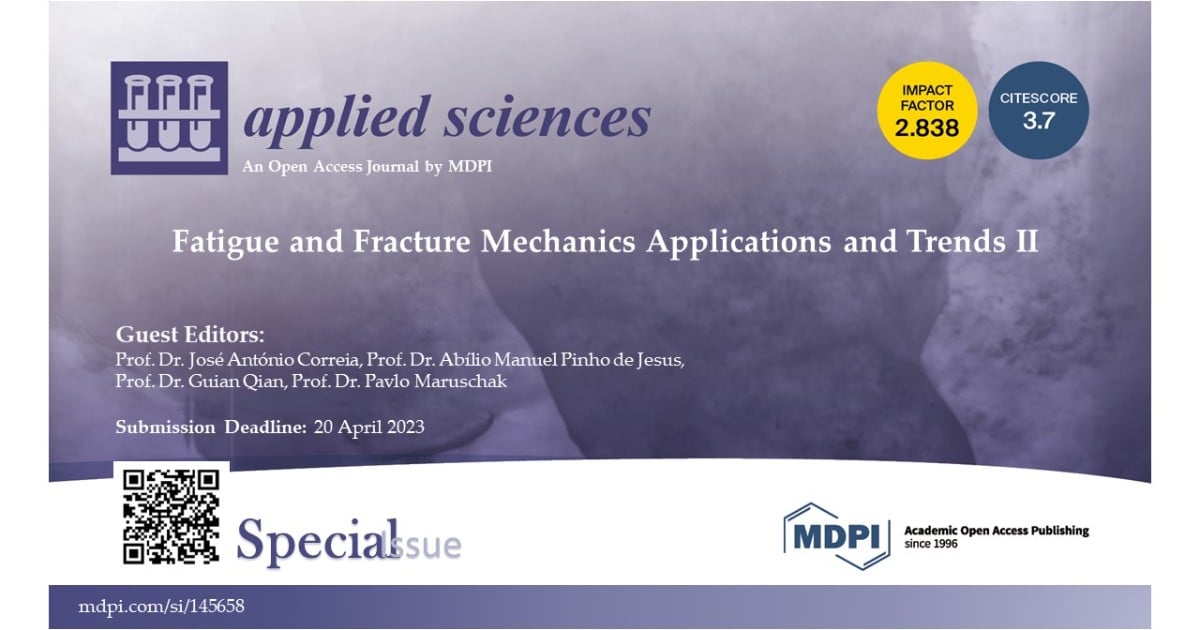Fatigue and Fracture Mechanics: Applications and Trends II
A special issue of Applied Sciences (ISSN 2076-3417). This special issue belongs to the section "Mechanical Engineering".
Deadline for manuscript submissions: closed (20 April 2023) | Viewed by 1616

Special Issue Editors
Interests: numerical modeling of engineering structures and structural components (offshore applications, steel bridges, pressure vessels, pipelines, wind turbine towers, etc.); mathematical problems in fatigue and fracture; mechanics of solids and structures; metals materials and structures; numerical fracture mechanics and crack growth; local approaches; finite element methods in structural mechanics applications; computer-aided structural integrity
Special Issues, Collections and Topics in MDPI journals
Interests: manufacturing processes; simulation; fracture mechanics
Special Issues, Collections and Topics in MDPI journals
Interests: fracture; ultra-high-cycle fatigue; additive manufacturing alloys
Special Issues, Collections and Topics in MDPI journals
Interests: mechanical properties; mechanical behavior of materials; material characterization; mechanical testing; finite element analysis
Special Issues, Collections and Topics in MDPI journals
Special Issue Information
Dear Colleagues,
This Special Issue (SI) covers a wide range of modern achievements in the study of the behavior of solids with cracks—from studies of cyclic durability and the nucleation and growth of a fatigue crack to solving a number of complex problems of fracture mechanics. In this SI, limiting and prelimiting equilibrium states of materials and structures under single, multiple, thermal, and dynamic loading in elastic, viscoelastic, and elastoplastic bodies with cracks will be considered. We also invite you to submit articles on new criteria for crack resistance of materials for structural integrity.
Considerable attention will be paid to the application of numerical methods for the analysis of stresses and strains in solids and constructions with notches and cracks. We will also be glad to see the results of studies on predicting the operability of structures according to the test data of laboratory samples, taking into account the scale factor based on similarity criteria for local fractures.
Considerable attention will be paid to research methods and the basic laws of fatigue and cyclic crack resistance of metals and alloys in deterministic and probabilistic settings. Also relevant for consideration are the characteristics of high cyclic fatigue for materials manufactured by new technological methods. We invite articles devoted to the basic laws of cyclic plasticity and fatigue of metals and alloys (especially those produced by additive manufacturing).
We also invite papers devoted to the deformation and energy criteria of fatigue fracture of metals estimation by FEM and experimental verification. Particular attention will be paid to the development of methods for accelerated determination of endurance limits based on deformation and energy criteria. The problem of predicting the development of cracks and probabilistic fatigue modeling will also be discussed.
Prof. Dr. José António Correia
Prof. Dr. Abílio Manuel Pinho de Jesus
Prof. Dr. Guian Qian
Prof. Dr. Pavlo Maruschak
Guest Editors
Manuscript Submission Information
Manuscripts should be submitted online at www.mdpi.com by registering and logging in to this website. Once you are registered, click here to go to the submission form. Manuscripts can be submitted until the deadline. All submissions that pass pre-check are peer-reviewed. Accepted papers will be published continuously in the journal (as soon as accepted) and will be listed together on the special issue website. Research articles, review articles as well as short communications are invited. For planned papers, a title and short abstract (about 100 words) can be sent to the Editorial Office for announcement on this website.
Submitted manuscripts should not have been published previously, nor be under consideration for publication elsewhere (except conference proceedings papers). All manuscripts are thoroughly refereed through a single-blind peer-review process. A guide for authors and other relevant information for submission of manuscripts is available on the Instructions for Authors page. Applied Sciences is an international peer-reviewed open access semimonthly journal published by MDPI.
Please visit the Instructions for Authors page before submitting a manuscript. The Article Processing Charge (APC) for publication in this open access journal is 2400 CHF (Swiss Francs). Submitted papers should be well formatted and use good English. Authors may use MDPI's English editing service prior to publication or during author revisions.
Keywords
- fatigue
- fracture mechanics
- fatigue crack growth
- structural integrity
- computer-aided fracture mechanics
- computer-aided structural integrity
- failure mechanisms
- cyclic plasticity
- applications and design codes
- probabilistic fatigue modeling








